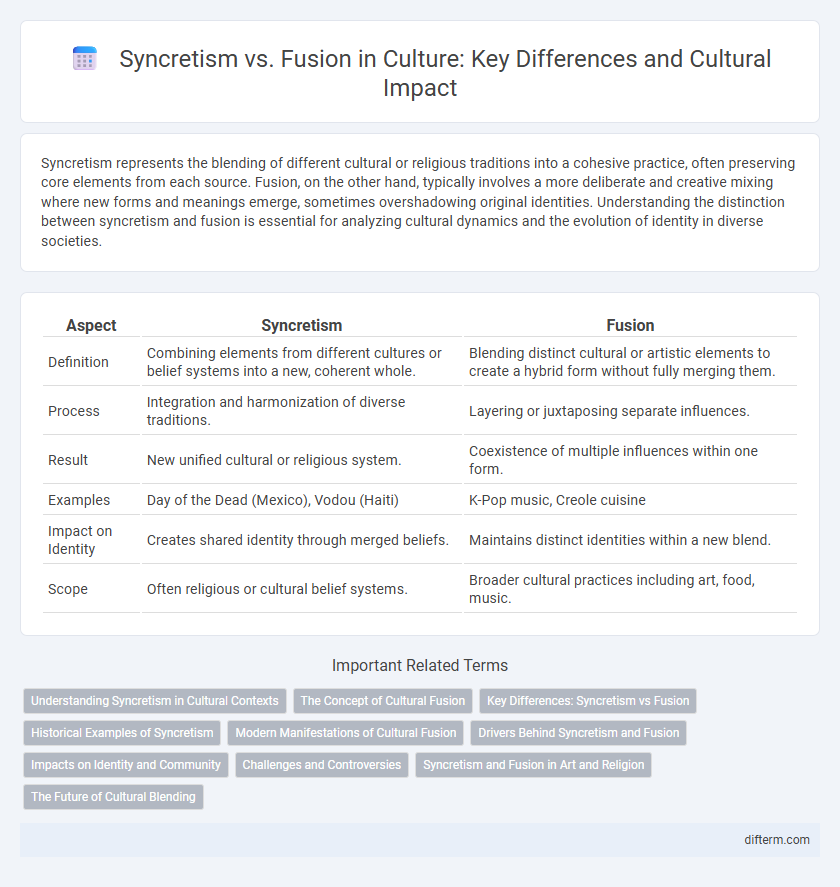Syncretism represents the blending of different cultural or religious traditions into a cohesive practice, often preserving core elements from each source. Fusion, on the other hand, typically involves a more deliberate and creative mixing where new forms and meanings emerge, sometimes overshadowing original identities. Understanding the distinction between syncretism and fusion is essential for analyzing cultural dynamics and the evolution of identity in diverse societies.
Table of Comparison
| Aspect | Syncretism | Fusion |
|---|---|---|
| Definition | Combining elements from different cultures or belief systems into a new, coherent whole. | Blending distinct cultural or artistic elements to create a hybrid form without fully merging them. |
| Process | Integration and harmonization of diverse traditions. | Layering or juxtaposing separate influences. |
| Result | New unified cultural or religious system. | Coexistence of multiple influences within one form. |
| Examples | Day of the Dead (Mexico), Vodou (Haiti) | K-Pop music, Creole cuisine |
| Impact on Identity | Creates shared identity through merged beliefs. | Maintains distinct identities within a new blend. |
| Scope | Often religious or cultural belief systems. | Broader cultural practices including art, food, music. |
Understanding Syncretism in Cultural Contexts
Syncretism in cultural contexts involves the blending of different religious, spiritual, or cultural beliefs into a cohesive system, reflecting historical interactions and exchanges among societies. This process often results in new traditions that preserve elements from original cultures while adapting to changing environments. Unlike fusion, which implies a straightforward mixing, syncretism entails a more complex negotiation of meanings and identities within cultural frameworks.
The Concept of Cultural Fusion
Cultural fusion refers to the dynamic process where distinct cultural elements merge to create new, hybrid traditions, practices, or identities, often resulting from prolonged contact and exchange. Unlike syncretism, which typically combines religious or philosophical systems to form a cohesive belief structure, cultural fusion spans broader social aspects, encompassing language, cuisine, art, and customs. This blending fosters innovation and diversity, exemplified by phenomena like creole languages and fusion cuisines, highlighting the adaptive and evolving nature of human cultures.
Key Differences: Syncretism vs Fusion
Syncretism involves the blending of distinct cultural or religious beliefs to form a new, cohesive system, preserving elements from each original tradition. Fusion refers to the merging of different cultural elements, often in art or cuisine, creating innovative forms without necessarily maintaining the original identities. Key differences lie in syncretism's emphasis on synthesizing belief systems or practices, whereas fusion prioritizes combining aspects to produce hybrid expressions.
Historical Examples of Syncretism
Syncretism in culture is evident in the historical blending of Greco-Roman religions with Egyptian beliefs during the Hellenistic period, forming syncretic deities like Serapis. Another prominent example includes the fusion of indigenous African spiritual traditions with Christianity, resulting in Afro-Caribbean religions such as Vodou and Santeria. These instances highlight syncretism as the complex, layered merging of cultural and religious elements, differing from simpler fusion by preserving distinct identities within a new, shared framework.
Modern Manifestations of Cultural Fusion
Modern cultural fusion manifests through globalized media, multicultural urban spaces, and hybrid art forms that blend traditional motifs with contemporary aesthetics. Syncretism, distinct from mere fusion, involves deeper integration of belief systems or practices, often creating entirely new cultural identities over time. Digital platforms accelerate these processes by facilitating cross-cultural exchanges that reshape music, fashion, and cuisine worldwide.
Drivers Behind Syncretism and Fusion
Syncretism arises primarily from prolonged cultural contact, where religious, linguistic, or social elements merge to form hybrid identities, often driven by historical colonization, trade, or migration. Fusion results from deliberate blending of cultural practices or artistic expressions, propelled by globalization, media exchange, and increasing intercultural communication. Both processes are influenced by power dynamics, adaptability, and the desire for social cohesion or innovation within diverse societies.
Impacts on Identity and Community
Syncretism blends diverse cultural and religious elements, creating hybrid identities that reshape community narratives and foster inclusivity. Fusion often results in the merging of art, music, and traditions, enhancing cultural expression while sometimes challenging traditional boundaries and collective cohesion. Both processes influence identity formation by balancing preservation with innovation, affecting how communities perceive themselves within broader societal frameworks.
Challenges and Controversies
Syncretism faces challenges in preserving the integrity of distinct cultural and religious traditions, often sparking controversies over perceived dilution or misinterpretation of original beliefs. Fusion, while celebrated for creative innovation, can provoke debates about cultural appropriation and the loss of authentic identities. Both processes raise complex issues regarding power dynamics, authenticity, and respect within multicultural interactions.
Syncretism and Fusion in Art and Religion
Syncretism in art and religion involves the blending of distinct cultural traditions and beliefs to create a new, cohesive system that retains elements of each origin. Fusion, by contrast, combines diverse styles or rituals in a way that highlights their unique characteristics without fully integrating them into a single framework. Syncretism often produces hybrid religious practices and artistic expressions that reflect historical interactions, while fusion emphasizes coexistence and dialogue between different cultural influences.
The Future of Cultural Blending
Syncretism and fusion represent dynamic processes of cultural blending, where syncretism merges distinct traditions into a coherent system while fusion combines elements without losing their original identities. The future of cultural blending lies in increasingly hybrid identities shaped by globalization, technology, and migration, promoting intercultural dialogue and innovation. Emerging cultural ecosystems will prioritize inclusivity and adaptability, fostering unique hybrid expressions that reflect diverse social realities.
Syncretism vs Fusion Infographic

 difterm.com
difterm.com